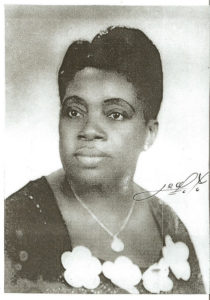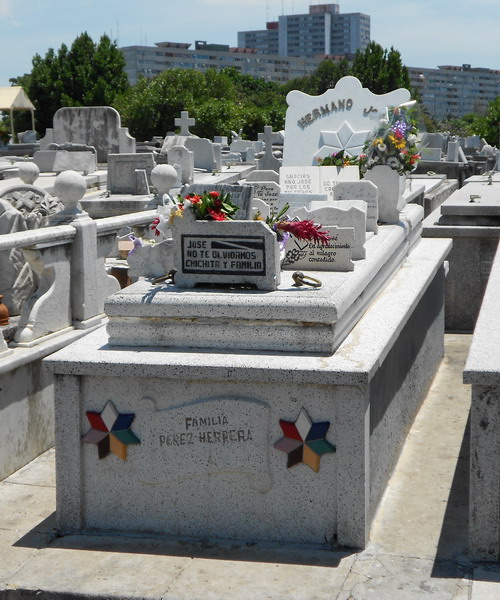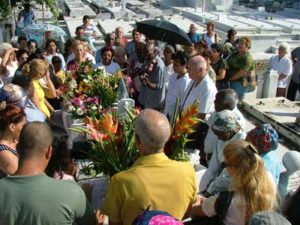 LEOCADIA PÉREZ HERRERA & “TÁ JOSÉ” STORY. TOMBS MORE VISIT AT COLÓN CEMETERY, HAVANA.
LEOCADIA PÉREZ HERRERA & “TÁ JOSÉ” STORY. TOMBS MORE VISIT AT COLÓN CEMETERY, HAVANA.
Leocadia Pérez Herrera was born on December 9, 1893 in Güines, Cuba, he was a medium who practiced crossed spiritism and through it passed a being called the ‘Brother José’, which they say, performed miracles.
According to the research on Leocadia, they say that, contrary to the oral tradition, the Afro-Cuban rituals or ceremonies were not used in his consultations. With only water, flowers and perfumes he managed to connect with the centennial spirit of the slave ‘Brother José’, venerated by believers of dissimilar religions of African and Haitian origin, who in many cases know him as ‘Tá José’.
Many are the myths that surround Leocadia, imagination and trust in their predictions shaped the beliefs around his life. For Jaciel Esculle Suárez, great-grandson, the most impressive is the portrait of Brother José. “It is said that the slave spirit ‘appeared’ to a blind painter and this guided by the entity captured every trace of his face. The canvas presided over séances.
Leocadia welcomed prominent personalities such as Ignacio Jacinto Villa Fernández (Bola de Nieve), and government figures such as Senator Heriberto Madrigal. Fulgencio Batista requested his services, but she rejected the conditions imposed on him; however, his wife, Marta Fernández, did consult her at times. It was also very venerated by people of limited resources who helped without receiving retribution.
A woven star with seven points and seven colors is the symbol that currently represents Brother Joseph. In the neighborhood of Víbora Park a temple was built, in his honor, in Santa Beatriz Street No. 52.
Currently Leocadia Perez Herrera and Brother José are venerated by many people, who make offerings to them in their tomb that is in the Cemetery of Columbus in Havana, at the time that they touch the rings, they ask for wishes and they place the bouquets of flowers .
Leocadia Pérez Herrera was buried, next to the canvas of Brother José, in a bronze coffin. The present ones affirmed that the painting was erasing and when introducing it in the coffin the face of the slave was completely blurred “. According to the story, Cuban musician Bola de Nieve, The Emperatriz del Danzonete, Paulina Álvarez, among other acquaintances, who attended their seances regularly, attended these celebrations of his death and were also accompanied by the participation of the National Symphony Orchestra.
Currently, the tomb of the medium in the Necropolis of Christopher Columbus, is the second most visited. Fans and devotees offer every March 19, San José day, a violin and other rituals, as well as melodies such as Ave María and Bella Cubana.
 HISTORIA DE LEOCADIA PÉREZ HERRERA Y EL “HERMANO JOSÉ”.TUMBAS MAS VISITADAS EN EL CEMENTERIO DE COLÓN, HABANA.
HISTORIA DE LEOCADIA PÉREZ HERRERA Y EL “HERMANO JOSÉ”.TUMBAS MAS VISITADAS EN EL CEMENTERIO DE COLÓN, HABANA.
Leocadia Pérez Herrera había nacido el 9 de diciembre de 1893 en Güines, Cuba, era un médium que practicaba el espiritismo cruzado y por ella pasaba un ser llamado el ‘Hermano José’, el que según cuentan, realizaba milagros.
Segun las investigaciones sobre Leocadia refiere que, al contrario de lo que cuenta la tradición oral, los ritos o ceremonias afrocubanos no eran empleados en sus consultas. Con solo agua, flores y perfumes lograba conectarse con el espíritu centenario del esclavo ‘Hermano José’, venerado por creyentes de disímiles religiones de origen africano y haitiano, quienes en muchos casos lo conocen como ‘Tá José’.
Muchos son los mitos que rodean a Leocadia, la imaginación y la confianza en sus vaticinios moldearon las creencias en torno a su vida. Para Jaciel Esculle Suárez, bisnieto, el más impresionante es el del retrato Hermano José. “Se dice que el espíritu esclavo se le ‘apareció’ a un pintor ciego y este guiado por el ente captó cada trazo de su rostro. El lienzo presidía las sesiones de espiritismo.
Leocadia acogió en su casa a destacadas personalidades como Ignacio Jacinto Villa Fernández (Bola de Nieve), y figuras del gobierno como el senador Heriberto Madrigal. Fulgencio Batista solicitó sus servicios, pero ella rechazó las condiciones que le impuso; sin embargo, a su mujer, Marta Fernández, sí la consultó en ocasiones. También fue muy venerada por personas de escasos recursos a quienes ayudaba sin recibir retribuciones.
Una estrella tejida de siete puntas y siete colores constituye el símbolo que representa actualmente al Hermano José. En la barriada de Víbora Park se le construyó un templo, en su honor, en la calle Santa Beatriz No. 52.
En la actualidad Leocadia Perez Herrera y el Hermano José son venerados por muchas personas, quienes les hacen ofrendas en su tumba que se encuentra en el Cementerio de Colón en La Habana, al tiempo que tocan las argollas, piden deseos y colocan los ramos de flores.
Leocadia Pérez Herrera fue enterrada, junto al lienzo del Hermano José, en un féretro de bronce. Los presentes afirmaron que la pintura se fue borrando y al momento de introducirla en el ataúd el rostro del esclavo estaba completamente desdibujado”. Según cuenta la historia, en sus funerales estuvo presente el músico cubano Bola de Nieve, La Emperatriz del Danzonete, Paulina Álvarez, entre otros conocidos, quienes asistían regularmente a sus sesiones espiritistas, ellos asistieron a estas celebraciones de su muerte y fueron acompañados además con la participación de la Orquesta Sinfónica Nacional.
Actualmente, la tumba de la médium en la Necrópolis de Cristóbal Colón, es la segunda más visitada. Fanáticos y devotos le ofrecen cada 19 de marzo, día de San José, un toque de violín y otros rituales, así como son escuchadas melodías como el Ave María y la Bella Cubana.
Agencies/Wiki/MemoriasCubanas/Internet Photos/ Arnoldo Varona/ TheCubanhistory.com
THE CUBAN HISTORY, HOLLYWOOD.








